Kentucky in 2025 offers both wonder and challenge. From the vast chambers of Mammoth Cave and the rare moonbow at Cumberland Falls to the heritage of Bardstown and the smoky flavor of western barbecue, the state blends natural beauty and cultural depth. Yet, commercialization, weak transit, and unpredictable weather remind travelers that exploration here demands flexibility.
1. Mammoth Cave: A World Beneath Our Feet

Mammoth Cave National Park in central Kentucky holds the record as the world’s longest known cave system, with more than 426 surveyed miles of passageways as of 2025, and new sections still being mapped.
Entering the cave feels like stepping into another planet: towering chambers suddenly collapse into narrow stone corridors before opening again into vast underground “cathedrals.” The steady 54 °F temperature provides relief from summer heat and a reminder of the cave’s ancient stability. Rangers guide tours that highlight not only geology but also history.
Prehistoric Native Americans explored the cave thousands of years ago, leaving artifacts still studied today, while enslaved guides in the 19th century played a critical role in mapping early sections. Visitors often experience a “lights out” moment, where total darkness makes it impossible to see even a hand in front of the face, linking modern explorers to all who ventured here before.
2. Cumberland Falls: The Moonbow Marvel
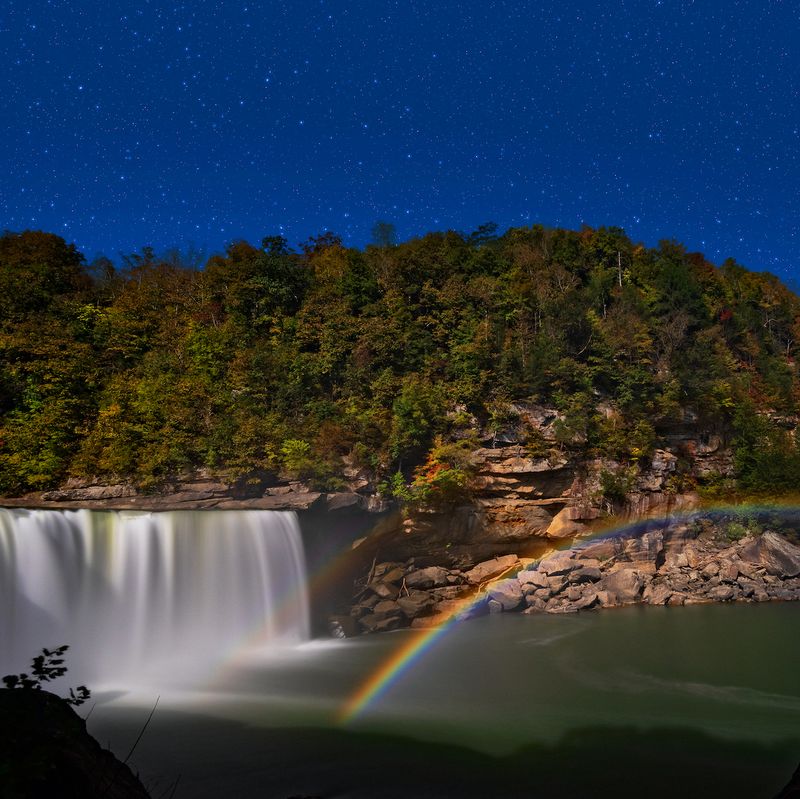
Cumberland Falls, located within Daniel Boone National Forest, is often called the “Niagara of the South,” but what sets it apart is the rare moonbow phenomenon. During clear nights around a full moon, the waterfall’s mist refracts moonlight into a faint, multicolored arc.
This natural event occurs consistently at Cumberland Falls, one of the few locations worldwide where moonbows are reliably visible. By day, the 68-foot-wide waterfall thunders over sandstone cliffs, creating dramatic scenery and misty rainbows that hover above the gorge. Trails of varying difficulty lead to overlooks where the falls can be viewed from different perspectives, and picnic areas along the riverbank invite slower exploration.
The surrounding forest is home to deer, black bears, and migratory birds, adding to the sense of immersion in Kentucky wilderness. While the moonbow is the headline attraction, even those visiting outside full-moon dates find the falls a breathtaking display of natural power.
3. Kentucky Horse Park: Living Heritage on Display

The Kentucky Horse Park near Lexington remains a unique combination of working horse farm, equine theme park, and international museum. Each day begins with horses grazing on rolling bluegrass pastures before joining demonstrations that showcase breeds from around the world.
In the Parade of Breeds, massive draft horses, sleek Arabians, and spotted gaited breeds are presented with historical context, reflecting how horses have shaped human societies for centuries. Visitors also tour the International Museum of the Horse, a Smithsonian affiliate, which traces equine history back 50 million years and details the role horses have played in transportation, agriculture, and sport.
The Hall of Champions honors famous racehorses that once thundered down Kentucky tracks. The park’s 1,200 acres include riding trails, training arenas, and barns open for tours, making it a dynamic, living celebration of the partnership between people and horses. No other place captures Kentucky’s equine heritage as completely.
4. Fort Boonesborough: Stepping Back in Time
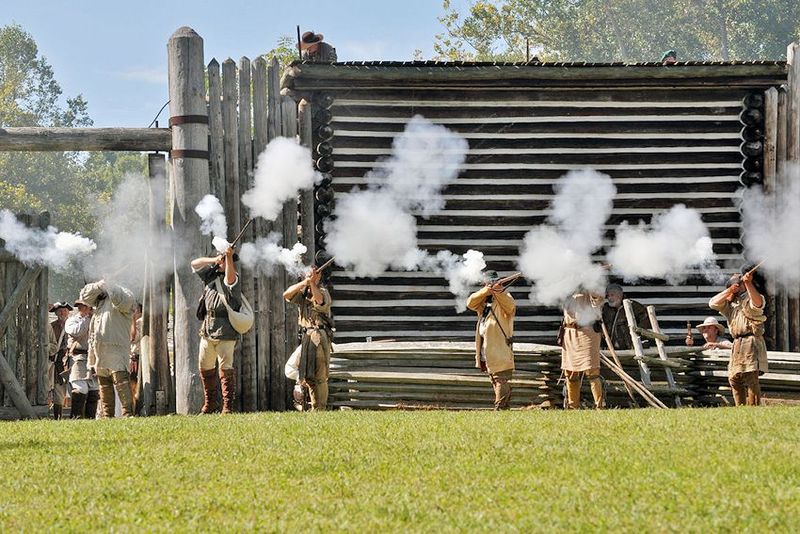
Fort Boonesborough State Park, set along the Kentucky River, reconstructs the 1775 settlement where Daniel Boone and pioneers established one of Kentucky’s first permanent outposts. Passing through the wooden gate feels like traveling back to frontier days.
Inside, costumed interpreters demonstrate the essential skills of 18th-century survival. A blacksmith shapes glowing iron into tools, while a weaver spins flax into linen thread. Visitors can try dipping candles, making rope, or writing with quills, activities that illuminate the effort required to survive on the frontier. The fort’s riverside setting highlights the importance of waterways, which served as highways for trade and communication in a largely wild landscape.
Archaeological research and historic documents guide the fort’s reconstruction, ensuring authenticity. Seasonal events such as frontier reenactments and living-history weekends bring larger crowds, yet on quiet days the site offers an intimate and reflective encounter with Kentucky’s colonial past and the perseverance of early settlers.
5. Red River Gorge: Nature’s Masterpiece
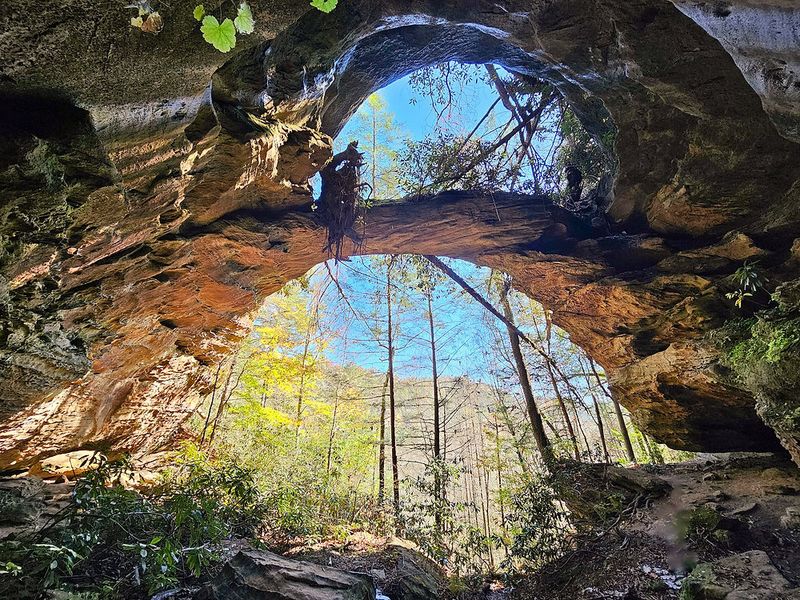
Eastern Kentucky’s Red River Gorge Geological Area offers some of the state’s most dramatic scenery, carved over millions of years from sandstone cliffs. Within its boundaries lie more than 100 natural arches, with the iconic Natural Bridge spanning 78 feet and standing 65 feet high.
The gorge is renowned internationally for sport climbing, drawing climbers from Europe, Asia, and across North America to test themselves on routes ranging from beginner to expert. For hikers, the network of trails weaves through dense hemlock and hardwood forests, passing seasonal waterfalls, rock shelters once used by Indigenous peoples, and overlooks with sweeping views of the Cumberland Plateau.
Autumn brings fiery foliage that contrasts with pale sandstone cliffs, while spring wildflowers cover the forest floor. Red River Gorge is also a designated National Natural Landmark and part of the Daniel Boone National Forest, underscoring its ecological and geological importance. For many, it feels like Kentucky’s crown jewel.
6. Bardstown: America’s Most Beautiful Small Town
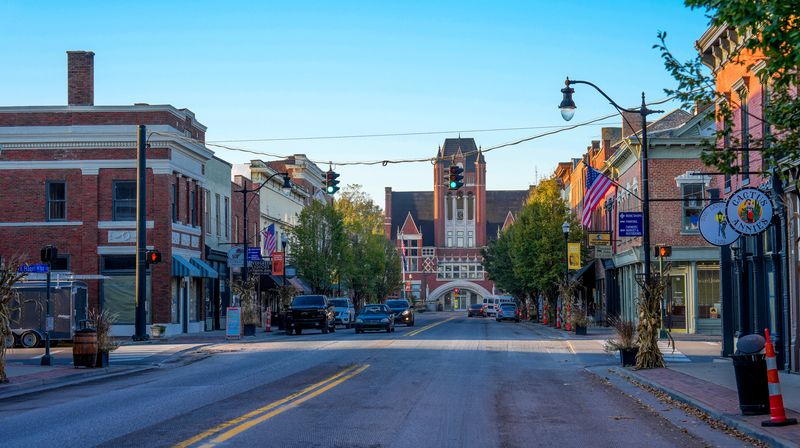
Founded in 1780, Bardstown is Kentucky’s second-oldest city and widely celebrated for its well-preserved architecture and sense of community. Downtown streets feature Federal-style buildings, cozy inns, and independent shops that give the town a timeless appeal. The 1892 courthouse anchors the square, often surrounded by seasonal festivals and farmers markets.
At My Old Kentucky Home State Park, visitors tour Federal Hill, an estate that inspired Stephen Foster’s state song, offering insights into 19th-century Kentucky society. Craftspeople in the area keep traditions alive by producing copper work and handmade goods.
While the town embraces tourism, it retains a balance of authenticity through community pride and historic preservation. The blend of architecture, cultural sites, and welcoming atmosphere has earned Bardstown recognition in travel features as one of America’s loveliest small towns.
7. Kentucky State Capitol: Unexpected Grandeur

Frankfort’s Kentucky State Capitol, completed in 1909, is a striking Beaux-Arts building constructed of native limestone and marble. Its symmetrical design and grand staircase reflect the architectural ideals of the early 20th century, and the building remains both a functioning seat of government and a public attraction.
The central rotunda displays statues of Abraham Lincoln, Jefferson Davis, and other notable Kentuckians, illustrating the state’s complex political heritage. Stained glass domes flood the chambers with natural light, adding to the sense of grandeur.
Visitors can take guided tours that include the Senate and House chambers when not in session, while the manicured Capitol grounds feature formal gardens and war memorials. Compared to many state capitols, Frankfort’s receives fewer tourists, which allows for a calmer exploration of the architecture. Its enduring beauty and accessibility make it one of Kentucky’s most impressive yet underappreciated public spaces.
8. Western Kentucky Barbecue: The Mutton Difference

Owensboro, in western Kentucky, anchors one of America’s most distinctive barbecue traditions: smoked mutton. Unlike the pork-dominated barbecue styles of the South, this regional specialty uses mature sheep slow-cooked over hickory for hours, producing a rich and slightly gamey flavor.
The meat is served with a dark, tangy “dip” sauce made of vinegar, Worcestershire, and spices. Local pitmasters trace this tradition back to Kentucky’s 19th-century wool industry, when older sheep were repurposed as food. Alongside barbecue, visitors often try burgoo, a hearty stew that combines multiple meats and vegetables into a thick, comforting dish.
These foods are served at church picnics, family reunions, and local restaurants, reinforcing their cultural importance. Owensboro’s International Bar-B-Q Festival each May celebrates this culinary heritage with competitions and community gatherings. For travelers seeking authentic Kentucky flavors, mutton barbecue and burgoo offer a direct link to regional history and resist the trend toward standardized American cuisine.
9. Disappointing: Tourist Trap Commercialization
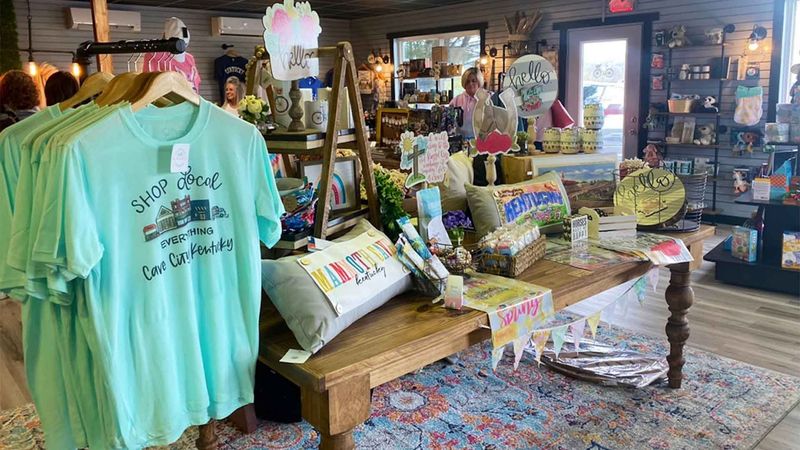
While many Kentucky towns emphasize authenticity, others have succumbed to tourist-oriented commercialization. Historic main streets that once featured craftspeople now host rows of shops selling mass-produced souvenirs marketed as “local.”
Restaurants in these areas sometimes rely on themed names rather than genuine recipes, charging higher prices without delivering distinctive Kentucky food. Large tour buses drop visitors for quick photos before moving on, reducing local culture to a backdrop for snapshots rather than an immersive experience. This emphasis on convenience and surface-level charm can obscure the deeper history and living traditions of the state.
The disappointment is not in Kentucky’s culture itself, which remains rich and diverse, but in how over-commercialization distorts it. Just beyond these corridors, authentic small businesses and community events thrive, yet visitors must venture away from the polished storefronts to find them. This divide leaves parts of Kentucky feeling packaged rather than real.
10. Disappointing: Limited Public Transportation
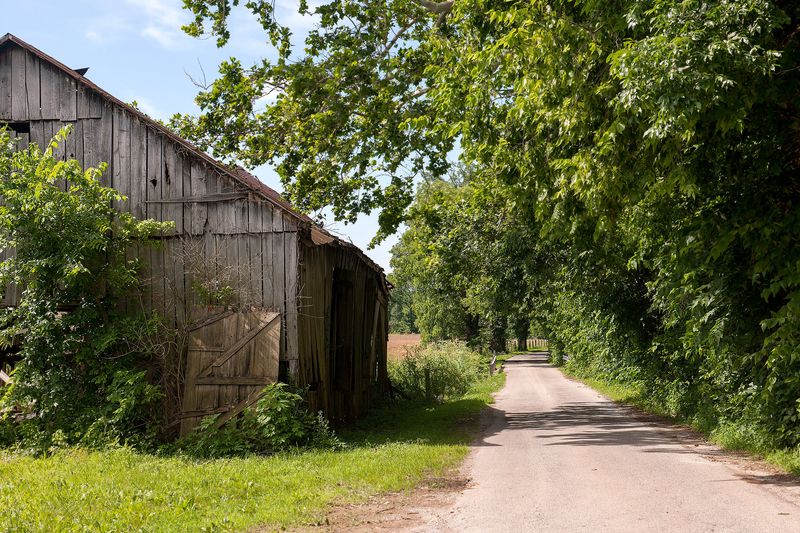
Kentucky’s landscapes invite exploration, but without a personal vehicle, reaching them can be nearly impossible. Public transportation in Louisville and Lexington exists but remains limited, serving commuters more than tourists.
Bus routes often run infrequently and cover only central areas, leaving neighborhoods and nearby attractions difficult to access. Rural Kentucky faces an even steeper challenge: most counties offer no fixed-route service at all, and only a handful operate on-demand shuttles or paratransit options. For travelers, this means rental cars or expensive rideshare trips are often the only practical choices. The lack of transportation alternatives isolates major natural attractions from visitors who may be unwilling or unable to drive.
As Kentucky works to grow its tourism sector, this gap remains one of its most significant barriers, restricting access for international visitors, budget travelers, and environmentally conscious tourists who might prefer car-free exploration.
11. Disappointing: Weather Unpredictability
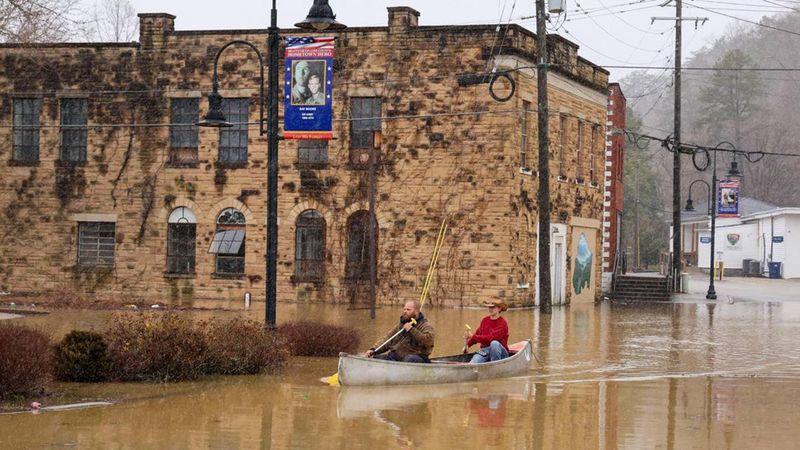
Kentucky’s weather patterns can change with startling speed, disrupting even the best-laid travel plans. During spring, sudden storms bring flash floods that close trails in areas like Red River Gorge. Summer heat waves push temperatures into the 90s °F, only to be followed by chilly nights. Autumn foliage season sometimes arrives early or late depending on rainfall, disappointing those planning trips around peak colors.
Even late spring is not immune, with occasional frost damaging gardens at public arboretums such as Bernheim Forest. Locals shrug off the instability with the phrase, “If you don’t like Kentucky weather, wait fifteen minutes,” reflecting how normal these fluctuations have become.
For travelers, the unpredictability requires flexibility, layered clothing, and backup plans for both indoor and outdoor activities. The state’s natural beauty remains undeniable, but visitors must prepare for surprises when weather refuses to cooperate.
Dear Reader: This page may contain affiliate links which may earn a commission if you click through and make a purchase. Our independent journalism is not influenced by any advertiser or commercial initiative unless it is clearly marked as sponsored content. As travel products change, please be sure to reconfirm all details and stay up to date with current events to ensure a safe and successful trip.